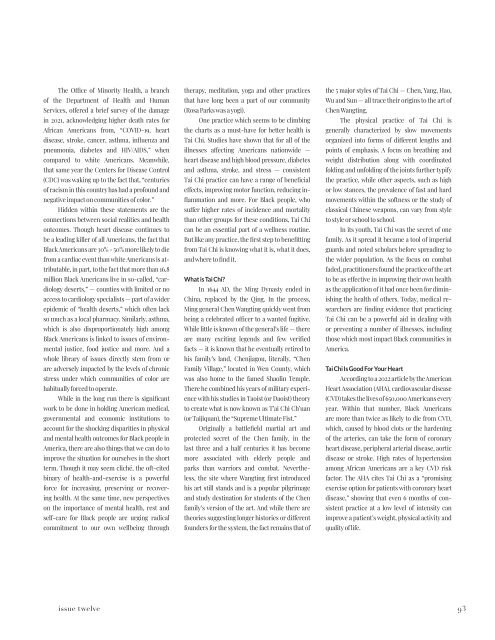AphroChic Magazine: Issue No. 12
Create successful ePaper yourself
Turn your PDF publications into a flip-book with our unique Google optimized e-Paper software.
The Office of Minority Health, a branch<br />
of the Department of Health and Human<br />
Services, offered a brief survey of the damage<br />
in 2021, acknowledging higher death rates for<br />
African Americans from, “COVID-19, heart<br />
disease, stroke, cancer, asthma, influenza and<br />
pneumonia, diabetes and HIV/AIDS,” when<br />
compared to white Americans. Meanwhile,<br />
that same year the Centers for Disease Control<br />
(CDC) was waking up to the fact that, “centuries<br />
of racism in this country has had a profound and<br />
negative impact on communities of color.”<br />
Hidden within these statements are the<br />
connections between social realities and health<br />
outcomes. Though heart disease continues to<br />
be a leading killer of all Americans, the fact that<br />
Black Americans are 30% - 50% more likely to die<br />
from a cardiac event than white Americans is attributable,<br />
in part, to the fact that more than 16.8<br />
million Black Americans live in so-called, “cardiology<br />
deserts,” — counties with limited or no<br />
access to cardiology specialists — part of a wider<br />
epidemic of “health deserts,” which often lack<br />
so much as a local pharmacy. Similarly, asthma,<br />
which is also disproportionately high among<br />
Black Americans is linked to issues of environmental<br />
justice, food justice and more. And a<br />
whole library of issues directly stem from or<br />
are adversely impacted by the levels of chronic<br />
stress under which communities of color are<br />
habitually forced to operate.<br />
While in the long run there is significant<br />
work to be done in holding American medical,<br />
governmental and economic institutions to<br />
account for the shocking disparities in physical<br />
and mental health outcomes for Black people in<br />
America, there are also things that we can do to<br />
improve the situation for ourselves in the short<br />
term. Though it may seem cliché, the oft-cited<br />
binary of health-and-exercise is a powerful<br />
force for increasing, preserving or recovering<br />
health. At the same time, new perspectives<br />
on the importance of mental health, rest and<br />
self-care for Black people are urging radical<br />
commitment to our own wellbeing through<br />
therapy, meditation, yoga and other practices<br />
that have long been a part of our community<br />
(Rosa Parks was a yogi).<br />
One practice which seems to be climbing<br />
the charts as a must-have for better health is<br />
Tai Chi. Studies have shown that for all of the<br />
illnesses affecting Americans nationwide —<br />
heart disease and high blood pressure, diabetes<br />
and asthma, stroke, and stress — consistent<br />
Tai Chi practice can have a range of beneficial<br />
effects, improving motor function, reducing inflammation<br />
and more. For Black people, who<br />
suffer higher rates of incidence and mortality<br />
than other groups for these conditions, Tai Chi<br />
can be an essential part of a wellness routine.<br />
But like any practice, the first step to benefitting<br />
from Tai Chi is knowing what it is, what it does,<br />
and where to find it.<br />
What is Tai Chi?<br />
In 1644 AD, the Ming Dynasty ended in<br />
China, replaced by the Qing. In the process,<br />
Ming general Chen Wangting quickly went from<br />
being a celebrated officer to a wanted fugitive.<br />
While little is known of the general’s life — there<br />
are many exciting legends and few verified<br />
facts — it is known that he eventually retired to<br />
his family’s land, Chenjiagou, literally, “Chen<br />
Family Village,” located in Wen County, which<br />
was also home to the famed Shaolin Temple.<br />
There he combined his years of military experience<br />
with his studies in Taoist (or Daoist) theory<br />
to create what is now known as T’ai Chi Ch’uan<br />
(or Taijiquan), the “Supreme Ultimate Fist.”<br />
Originally a battlefield martial art and<br />
protected secret of the Chen family, in the<br />
last three and a half centuries it has become<br />
more associated with elderly people and<br />
parks than warriors and combat. Nevertheless,<br />
the site where Wangting first introduced<br />
his art still stands and is a popular pilgrimage<br />
and study destination for students of the Chen<br />
family’s version of the art. And while there are<br />
theories suggesting longer histories or different<br />
founders for the system, the fact remains that of<br />
the 5 major styles of Tai Chi — Chen, Yang, Hao,<br />
Wu and Sun — all trace their origins to the art of<br />
Chen Wangting.<br />
The physical practice of Tai Chi is<br />
generally characterized by slow movements<br />
organized into forms of different lengths and<br />
points of emphasis. A focus on breathing and<br />
weight distribution along with coordinated<br />
folding and unfolding of the joints further typify<br />
the practice, while other aspects, such as high<br />
or low stances, the prevalence of fast and hard<br />
movements within the softness or the study of<br />
classical Chinese weapons, can vary from style<br />
to style or school to school.<br />
In its youth, Tai Chi was the secret of one<br />
family. As it spread it became a tool of imperial<br />
guards and noted scholars before spreading to<br />
the wider population. As the focus on combat<br />
faded, practitioners found the practice of the art<br />
to be as effective in improving their own health<br />
as the application of it had once been for diminishing<br />
the health of others. Today, medical researchers<br />
are finding evidence that practicing<br />
Tai Chi can be a powerful aid in dealing with<br />
or preventing a number of illnesses, including<br />
those which most impact Black communities in<br />
America.<br />
Tai Chi Is Good For Your Heart<br />
According to a 2022 article by the American<br />
Heart Association (AHA), cardiovascular disease<br />
(CVD) takes the lives of 650,000 Americans every<br />
year. Within that number, Black Americans<br />
are more than twice as likely to die from CVD,<br />
which, caused by blood clots or the hardening<br />
of the arteries, can take the form of coronary<br />
heart disease, peripheral arterial disease, aortic<br />
disease or stroke. High rates of hypertension<br />
among African Americans are a key CVD risk<br />
factor. The AHA cites Tai Chi as a “promising<br />
exercise option for patients with coronary heart<br />
disease,” showing that even 6 months of consistent<br />
practice at a low level of intensity can<br />
improve a patient’s weight, physical activity and<br />
quality of life.<br />
issue twelve 93

















